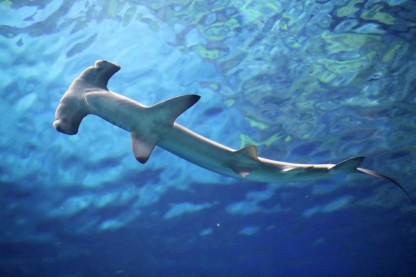We have our very own Big Five, which you won’t want to miss when you visit the National Aquarium Denmark.
The Big Five is an old expression coined by big game hunters in reference to the five most dangerous animals on the Savannah. The expression has since been popularised by the safari industry.
However, the National Aquarium’s Big Five are neither deadly dangerous nor traditionally hunted. Instead, our Big Five are the coolest, funniest, cutest, noblest and most beautiful and amazing creatures we have in our aquarium. And we highly recommend you see them for yourself. You can meet them here:
1. The sea otters – with the appetite of a family of ten and full of energy
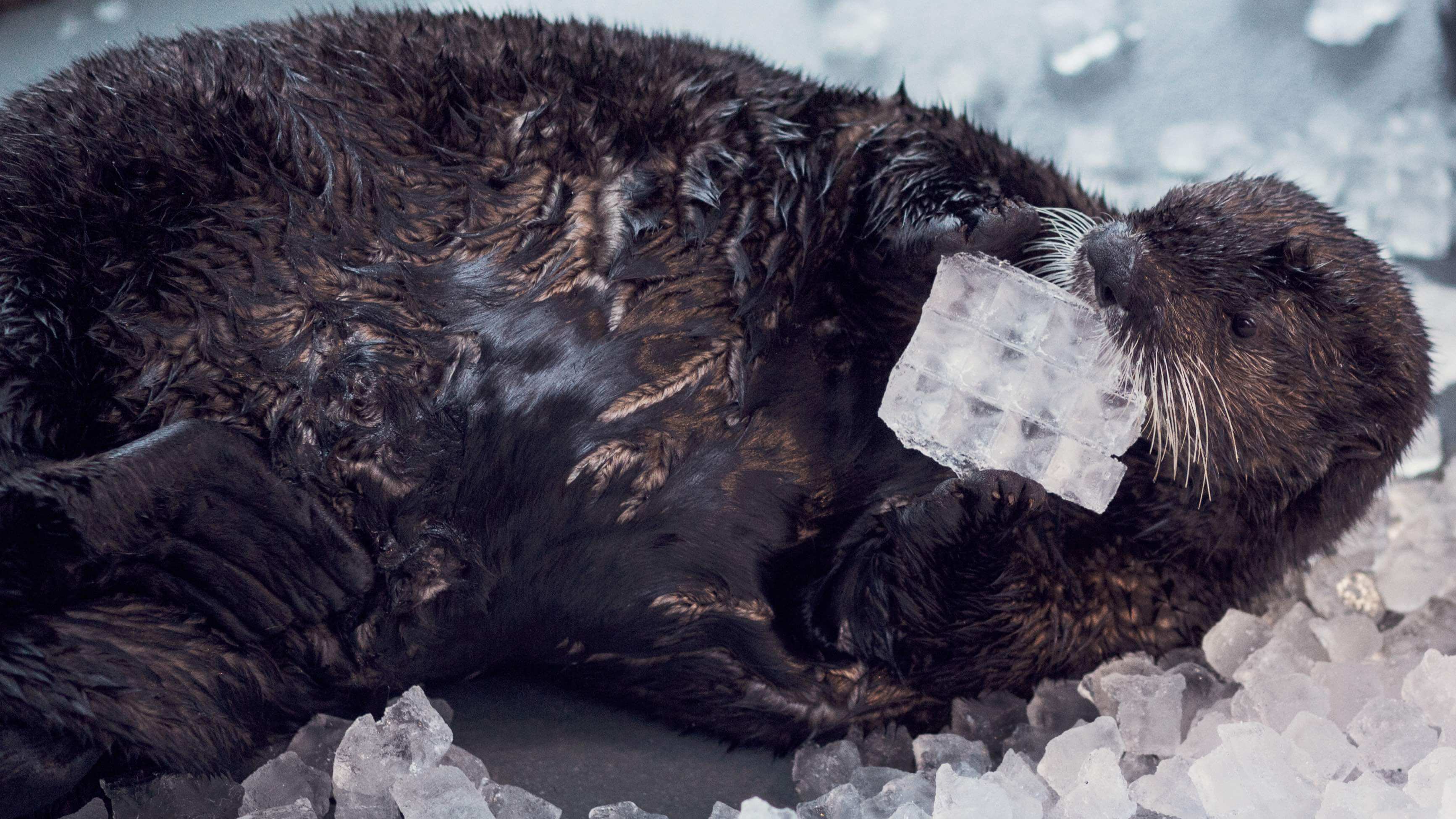
Sea otters are entertaining and adorable, and you can easily spend hours watching them.
What to look for
Sea otters have excellent table manners. They use rocks to crush shellfish and mussels, using their tummies as tables as they float on their backs.
They are known for having the thickest fur of all mammals. They have up to 155,000 hairs per square centimetre – for comparison, a human head contains around 100,000 hairs.
We are lucky enough to have added two new sea otters to our enclosure, so our resident sea otters Agnes and Mojoe have been joined by Riggs and Dixon.
The size of the National Aquarium Denmark’s sea otters (approx.):
Mojoe weighs 30 kg and is 130 centimetres long
Agnes weighs 22 kg and is 100 centimetres long
Dixon weighs 17 kg and is 90 centimetres long
Riggs weighs 16 kg and is 90 centimetres long
Fun fact
It takes a lot of food to keep these two energetic marine animals going all day. Together they eat nearly 18 kg of food a day.
You will find the sea otters in their very own habitat, where they splash about and play all day long to the delight of visitors of all ages.
2. The hammerhead sharks – shrewd hunters with odd-shaped heads

The majestic hammerhead is beautiful as it glides through the water, swinging its hammer-shaped head from the side to side.
What to look for
Hammerheads are shrewd predators. They have special sensing organs called ampullae of Lorenzini, which enable them to sense electric fields as they scan their surroundings for fish. The ampullae are primarily clustered in the head and the “hammer”. This gives the hammerhead the advantage of being able to search a large area with its hammer, sensing the tiny electrical impulses emitted by the muscles and hearts of their prey.
The head is hammer-shaped, not because the shark has swallowed a hammer, but because it is a tool for finding food. The hammerhead shark moves its head from side to side as it swims, using its head like a metal detector to scan a much larger area than other sharks.
The size of the National Aquarium Denmark’s hammerhead sharks:
The largest hammerheads are approx. 2 metres long, but they can grow to be more than 4.3 metres long.
The hammerhead is a relatively light-weight animal, despite its length. No one knows the exact weight of the National Aquarium Denmark’s hammerheads, but they can weigh up to 150 kg.
The hammerheads are fed twice a day with a variety of fish, such as mackerel, salmon and cod.
Fun fact
The hammerheads at the National Aquarium Denmark are quite finicky. They love it when we serve them salmon, but are not nearly as enthusiastic when cod is on the menu.
You will find the hammerheads in the National Aquarium Denmark’s largest tank – the Ocean aquarium.
3. The stingrays – peaceful fish with a deadly weapon
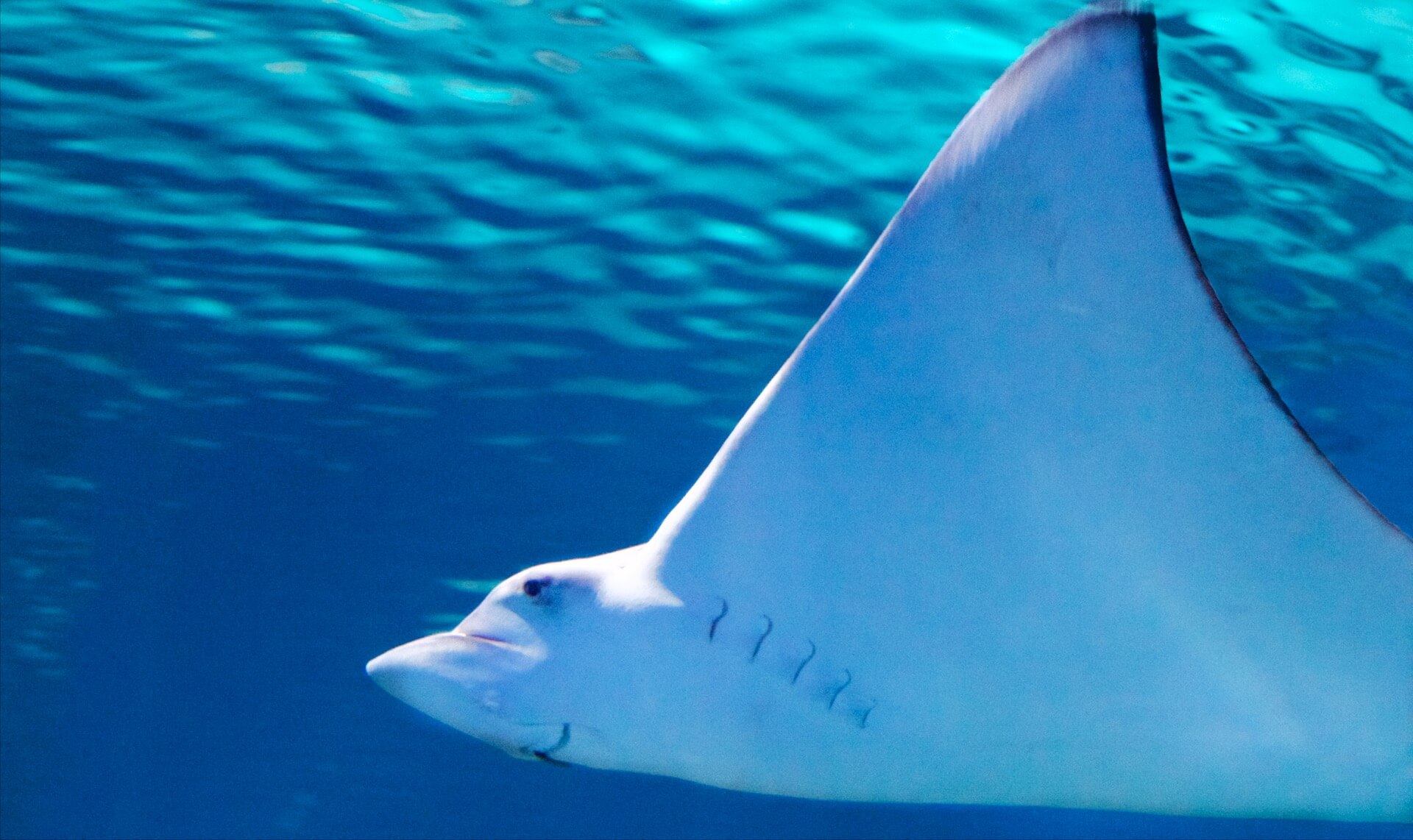
Most know stingrays as large fish with very long and beautiful tails.
What to look for
At the base of their tail, they also have a poisonous barbed stinger which can cause death. It was a stingray sting that took the life of famed “Crocodile Hunter” Steve Irwin in Australia in 2006. However, the stingray is actually a very peaceful animal, which primarily lives on the seabed. It only stings its enemies when it is frightened or feels threatened. It is very elegant and graceful as it glides over the seabed with its undulating “wings”.
The size of the National Aquarium Denmark’s stingrays:
The National Aquarium Denmark is home to several species of stingrays. They have different colours, sizes and appearances. The largest stingrays live in the Ocean aquarium, but there are also smaller freshwater stingrays in the Rain Forest.
The largest stingrays are approx. 120 centimetres in diameter and weigh around 80 kg.
The stingrays are fed twice a day, and guests can watch at the large Ocean aquarium, where they can also hear stories about the fish in the aquarium.
Fun fact
The large stingrays in the Ocean aquarium are fed by hand by the aquarium staff every day. The clever fish know where they are usually fed and always swim to a specific spot at the top of the Ocean aquarium, where they are rewarded with the fish of the day.
You will find the stingrays along with the hammerheads in the Ocean aquarium (36). But there are also several different stingrays in the other aquariums, so keep an eye out for these graceful creatures.
4. The giant Pacific octopus – a clever mollusc with nearly 2,000 suction cups
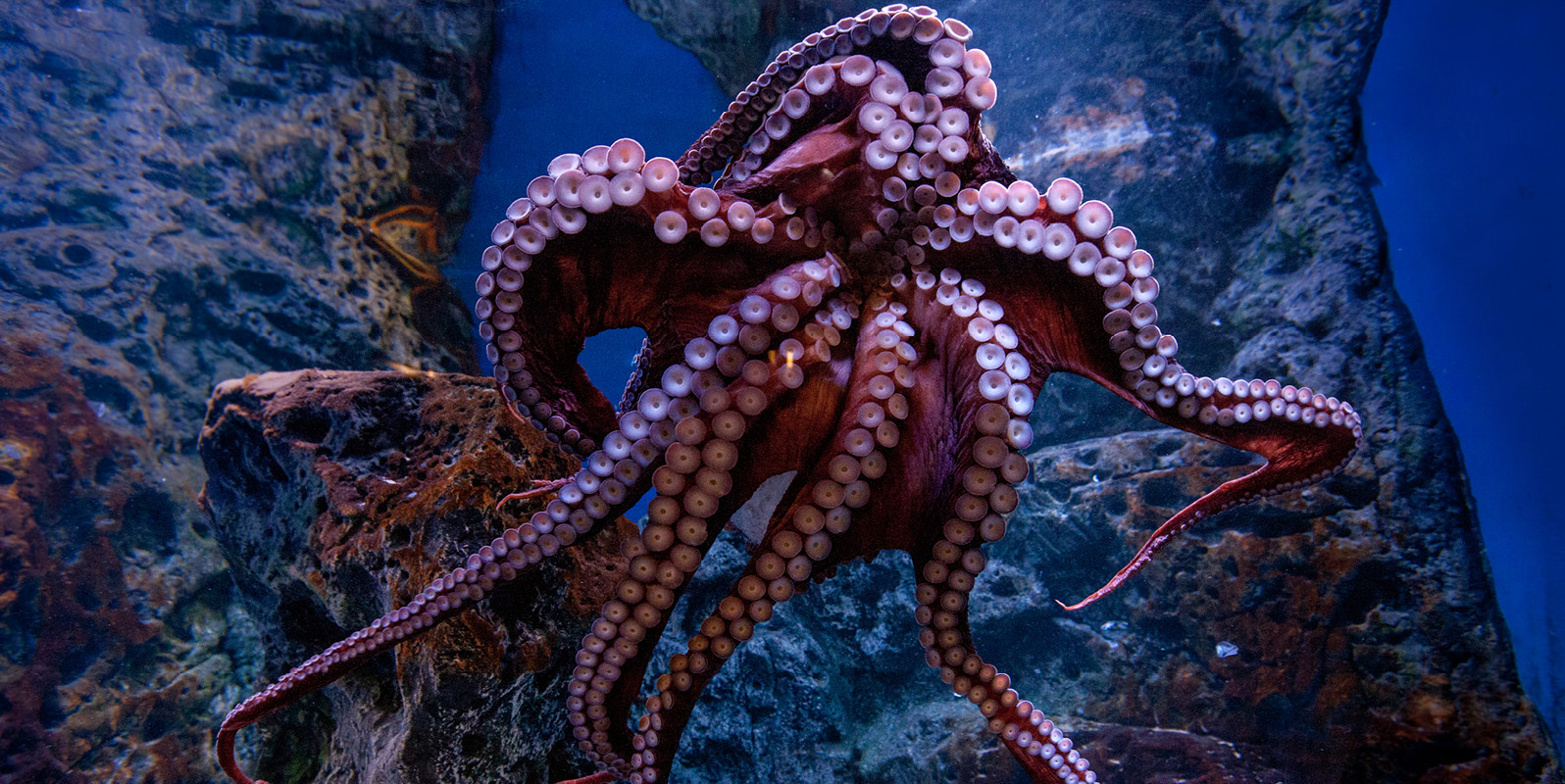
The giant Pacific octopus is a fascinating sea creature with so many talents, you could call it Superman.
What to look for
It is excellent at hiding because it can change skin colour and texture to resemble its surroundings. It has a highly evolved brain and is said to be as smart as a dog. The National Aquarium Denmark’s octopus can screw the lid off a jam jar – something even a dog can’t do ;-).
The size of the National Aquarium Denmark’s octopus:
The giant Pacific octopus at the National Aquarium Denmark is approx. 1.5 meters long. Its weight is unknown.
It is fed crabs, shellfish and other bottom-dwellers.
Fun fact
The aquarium staff have lined the edge of the octopus tank in the basement with a special mat, which makes suction cups useless. This is to keep the giant Pacific octopus from crawling over the side and out of the tank.
You will find the giant Pacific octopus in aquarium no. 14. It likes to stay hidden in its little cave, but it usually emerges at feeding time when it shows off its beautiful long arms and nearly 2,000 suction cups.
5. The arapaima – giants of the sea with practical scales
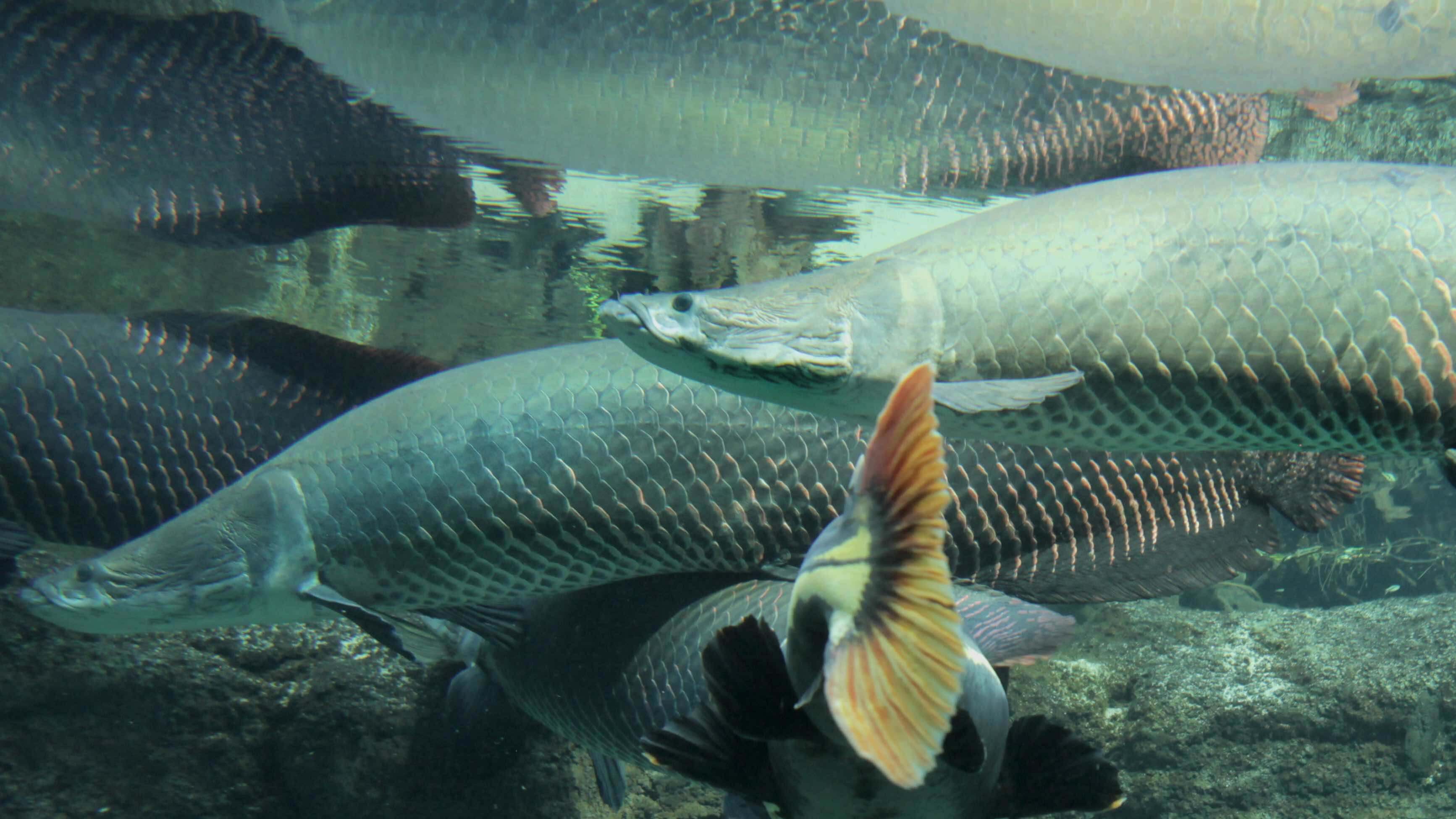
What to look for
Is it possible to travel back in time? Looking at the arapaima comes pretty close, since millions of years ago it lived with the dinosaurs. The arapaima is a survivor of the fifth mass extinction event that took place 65 million years ago. It has survived all these many years thanks to the protective layer of scales covering its body. The scales can be up to 6 cm long and are extremely hard.
The size of the National Aquarium Denmark’s arapaimas:
The arapaima is one of the largest freshwater fish in the world and can grow up to 3 meters long. The National Aquarium Denmark’s arapaima weigh 60-70 kg and are almost a meter long.
They are fed daily during storytelling time in front of their aquarium.
You will find the arapaima in the Rain Forest in aquarium no. 23. Keep an eye out for these prehistoric giants and listen to them at feeding time – the unmistakable sound can be heard in the Rain Forest section.
Fun fact
Even though the arapaima is a big fellow, it is not particularly fast. It therefore uses a clever technique to capture its prey. The giant fish creates a vacuum in the water with its mouth to literally suck in its prey. The maneuver produces a loud bang that will make you jump.

